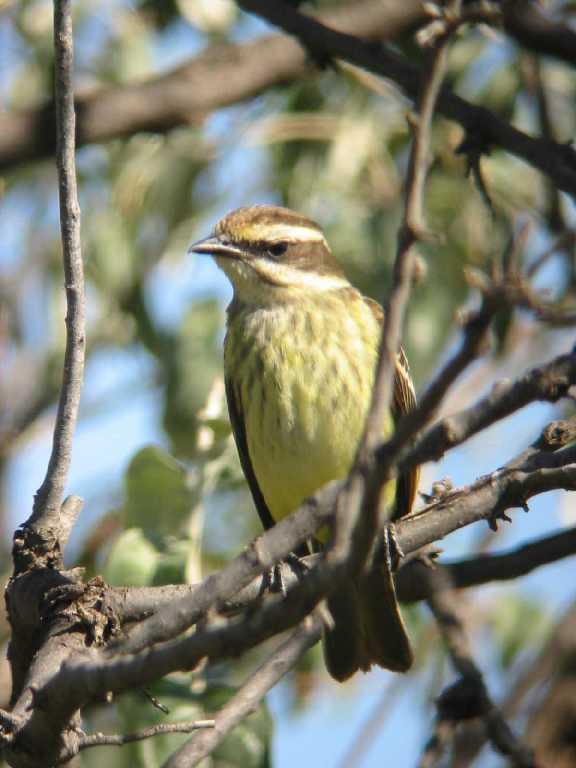 On September 12, 2003 a vagrant from southern Mexico suddenly appeared at Bosque Redondo near Fort Sumner, NM. It was afterwards seen by multiple observers and identified as a Piratic Flycatcher, distinguished from the larger Variegated Flycatcher by its small bill, nearly unstreaked back and less extensive rufous areas on its tail. I was lucky to take several photos, posted here.
On September 12, 2003 a vagrant from southern Mexico suddenly appeared at Bosque Redondo near Fort Sumner, NM. It was afterwards seen by multiple observers and identified as a Piratic Flycatcher, distinguished from the larger Variegated Flycatcher by its small bill, nearly unstreaked back and less extensive rufous areas on its tail. I was lucky to take several photos, posted here.
It gets its name from the manner in which it nests. Rather than building its own, it harasses other species of flycatcher until they abandon their nests, then does some remodeling before laying its own eggs.
The breeding range of Piratic Flycatchers extends from Mexico and Central America down to northern Argentina and southern Brazil. The northern population migrates south from Mexico to Costa Rica between the months of January and February, and the southernmost population moves northward to spend the austral winter (our summer) the Amazon region. In March of 2006, another Piratic Flycatcher was reported from Bentsen-Rio Grande Valley State Park in Texas.
The following is an excerpt from: http://animaldiversity.ummz.umich.edu/accounts/legatus/l._leucophaius$narrative.html
Piratic Flycatchers breed between the months of February and August. They wait till other flycatchers construct their nests, then force them to abandon the area. These nests are located high up in trees. Piratic Flycatchers annoy their victims to the point of distraction, remove any remaining eggs that inhabit the nest, and utilize the nest for their needs. They annoy their victims by entering the nests numerous times during the day and bothering the birds. Piratic Flycatchers rarely attack their victims, but rather provoke fights. The nests which the Piratic Flycatchers inhabit are enclosed and have a dome shape to them. These birds frequently add leaves to the nests to aid in cushion and warmth.
Piratic Flycatchers usually lay 2 to 3 eggs at one time; occasionally up to as many as 4 eggs. The eggs are a dark brown color and have scattered black spots on them. Subtle black lines are also present on the larger end of the egg. The eggs range in size from 16 to 22.5 mm (.6 to .8 in.). Female Piratic Flycatchers incubate alone for a period of 15 to 16 days. After 18 to 20 days, the young Piratic Flycatchers leave the nest and begin a life of their own. From this point on, the young birds do not rely on their parents for food or shelter.
(Schmalz, 2001; French, 1973; Stiles and Skutch, 1989)
We missed seeing it when we stopped by on the morning of September 14 while on our way to Amarillo to visit three of our grandchildren.
On our way back to Albuquerque on September 16, we arrived at about 8:30 AM to hear that it had been seen only 20 minutes earlier. Luckily, we re-found it at 9:10 AM and observed it for almost an hour. The bird ate Russian Olive fruits. It hovered (fluttered rather clumsily) as it plucked the olives from the tree. Once it made a brief foray and caught and ate a medium-sized dragonfly. We did not hear any vocalizations.
This was only the third confirmed sighting of this ever recorded in the USA, the second for New Mexico. A photograph of a fourth Piratic Flycatcher, in Florida, was identified some time after it was sighted.












